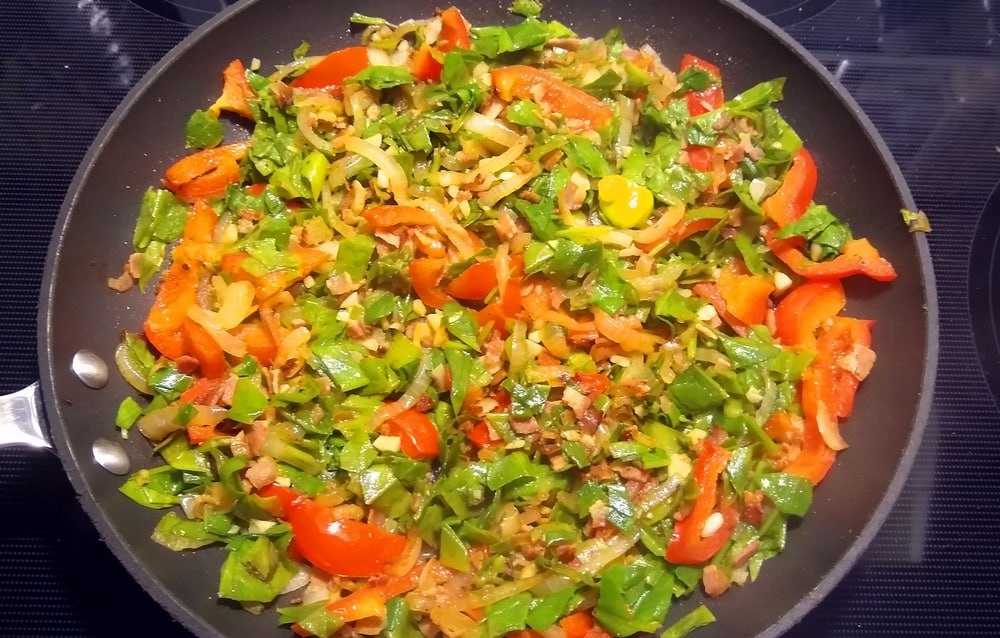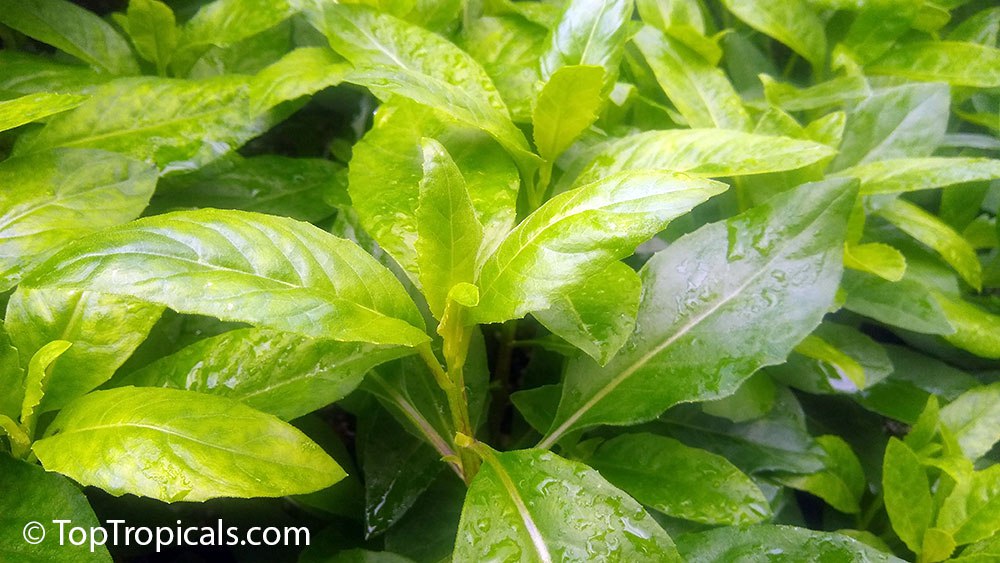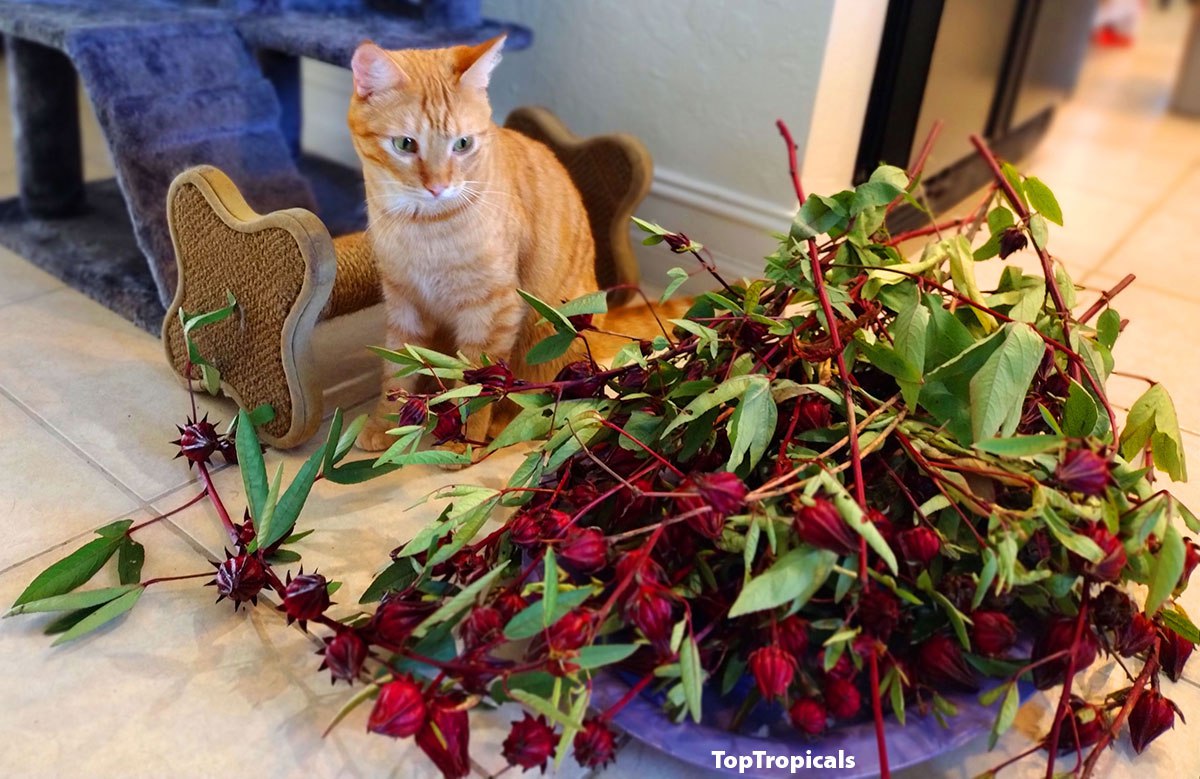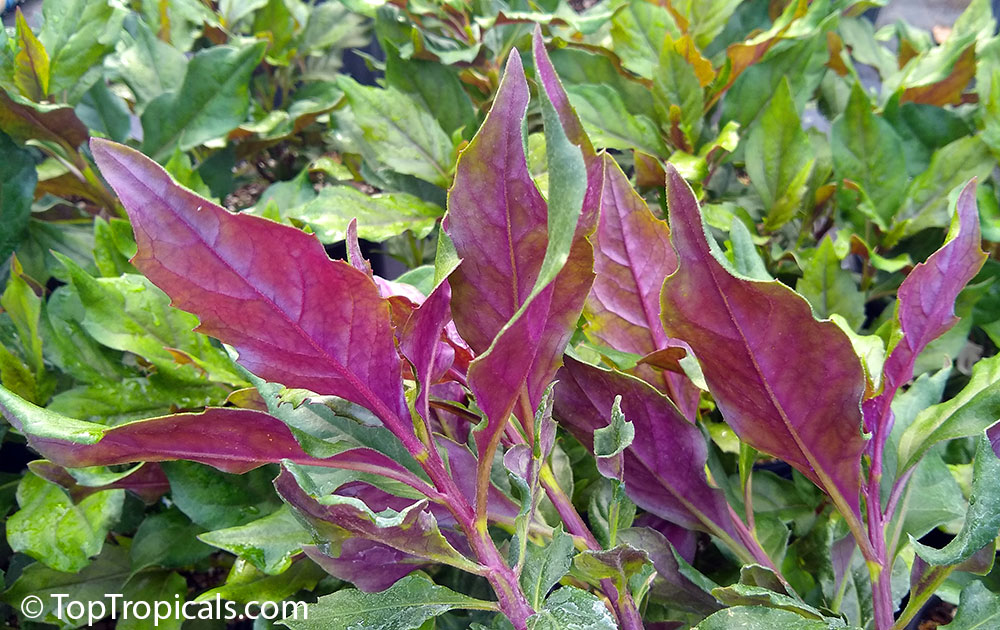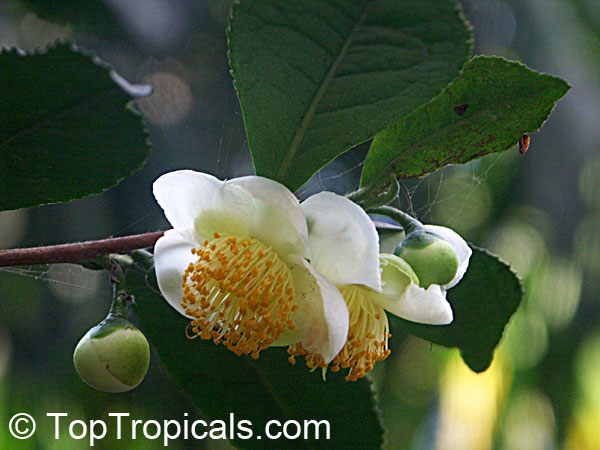Garden Blog - Top Tropicals
How to make healthy food taste delicious? Longevity Spinach Super-food Recipes
- ☘️ Gynura procubens (Longevity Spinach, Okinawa Spinach) is one of the Superfoods, known for its longevity-promoting properties in traditional medicine.
- ☘️ Native to Indonesia, commercially grown in China. It is a relatively hardy perennial that once planted, you will have these healthy greens for many years!
- ☘️ Both the stems and the leaves are edible and nutritious, can be eaten raw or cooked. They have a unique flavor with a faint hint of pine, and will add a beautiful aesthetic element to cuisine.
- ☘️ This green is also known as cholesterol spinach, and there are many claims that it lowers can cholesterol.
- ☘️ Perfect for hot and humid climates unlike traditional Spinach that only grown in cooler areas. It will thrive in any type of soil, any type of light other than dark shade, and is pest-free.
- ☘️ Very adaptable to container gardening and even grows well on a windowsill.
- ☘️ The leaves and young shoot tips can be steamed, used in stir fry, tempura, stews, and soups. Just add them at the very end.
Check out the recipes⬇️⬇️⬇️
📚 Gynura: Longevity Spinach Superfood Recipes
🎥 Best Hot Weather Spinach Crops - Longevity and Okinawa Spinach
🛒 Plant Longevity Spinach and live long
#Food_Forest #Recipes #Remedies
🏵 TopTropicals
Do you have Longevity Spinach in your garden?

Gynura crepioides - Okinawa Spinach, Purple leaves
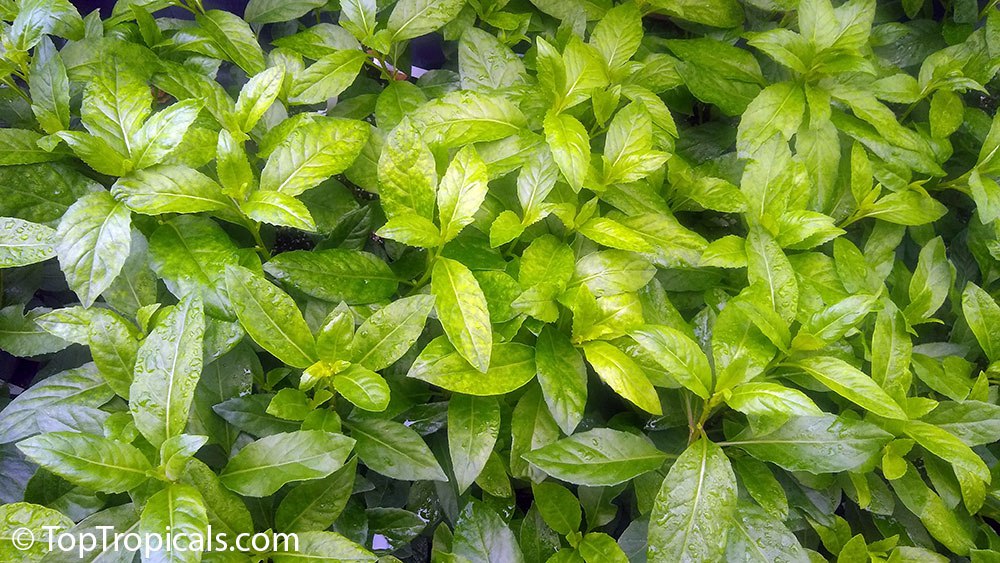
Longevity Spinach (Gynura)
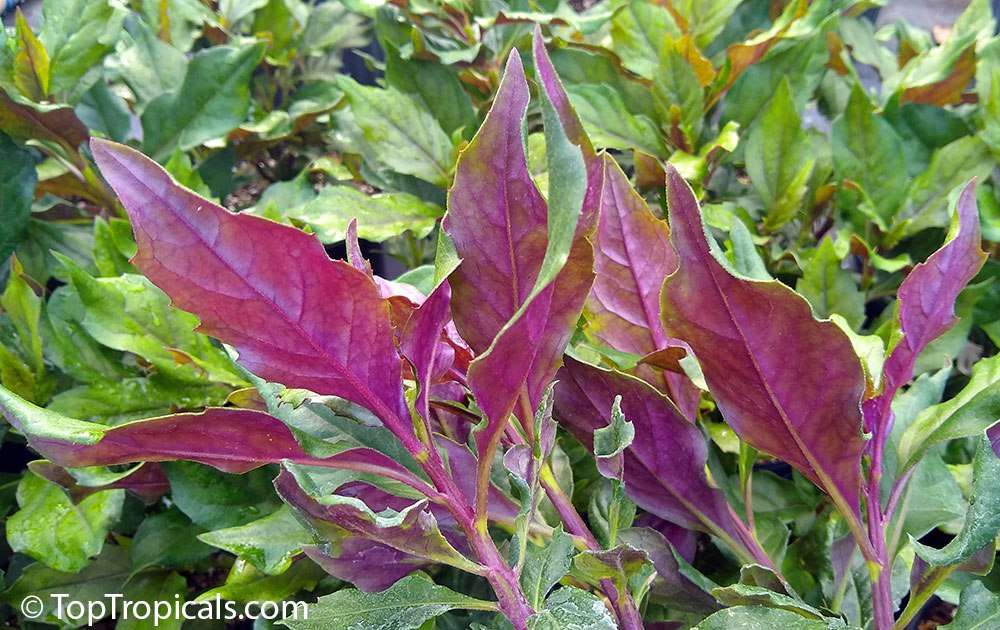
Gynura crepioides - Okinawa Spinach, Purple leaves
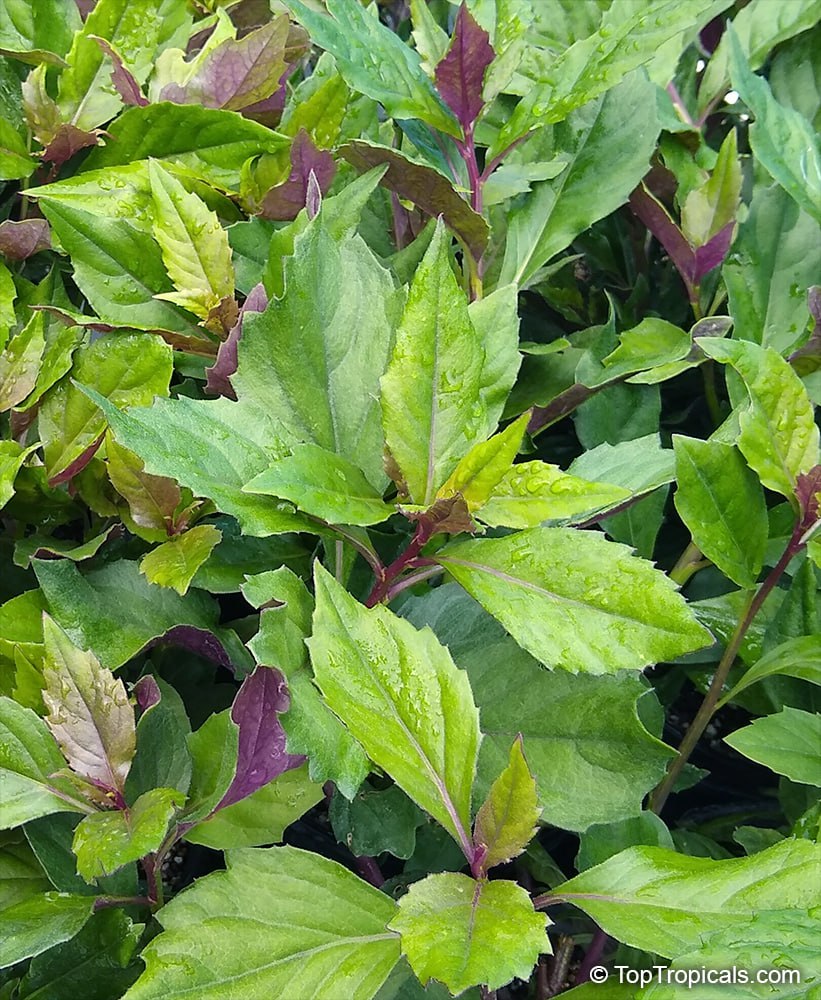
Gynura crepioides - Okinawa Spinach, Purple leaves
- Longevity Spinach (Gynura) is a leafy green plant known for its mild flavor and nutritional benefits. It is one of the Superfoods, known for its longevity-promoting properties in traditional medicine. There are two varieties - Green (Gynura procubens) and Purple leaves (Gynura crepioides - Okinawa Spinach).
- It's often used in Southeast Asian cuisine, added to soups, stews, and salads for its health-promoting properties, including immune support and improved digestion.
- It is prized for being easy to grow and rich in vitamins and antioxidants. This green is also known as cholesterol spinach, and there are many claims that it lowers can cholesterol.
- Perfect for hot and humid climates unlike traditional Spinach that only grown in cooler areas. It will thrive in any type of soil, any type of light other than dark shade, and is pest-free.
- Very adaptable to container gardening and even grows well on a windowsill.
- The leaves and young shoot tips can be steamed, used in stir fry, tempura, stews, and soups. Just add them at the very end.
Check out the recipes⬇️⬇️⬇️
📚 Learn more:
5 most useful edibles for tropical garden
How to make healthy food taste delicious: Longevity Spinach Super-food Recipes
Gynura: Longevity Spinach Superfood Recipes
🎥 Best Hot Weather Spinach Crops - Longevity and Okinawa Spinach
🛒 Plant Longevity Spinach and live long
#Food_Forest #Recipes #Remedies
🔴 Join 👉 TopTropicals
Date:
Growing Barbados Cherry in container
Q: I am interested in buying some Barbados cherry plants. Could you please advise if these can be grown in containers indefinitely or it's still better for them to be planted in ground for nutrients etc?
A: The Barbados cherry, like other tropical cherry varieties, is exceptionally well-suited for cultivation in containers.
Barbados cherry grows into a dense bush, demands minimal pruning, and begins bearing fruit at a young age. Our plants, which are propagated from cuttings, initiate the flowering and fruiting process in the very same year. They produce fruit almost year around. This year we've had three big crops: April, July and October (still fruiting now!) besides sporadic fruiting throughout the warm season.
You can cultivate Barbados cherry in a pot, commencing with a 1-3 gallon container and gradually increasing the size each year. Below is a photo of a fully developed tree in the ground, for reference. This tree is approaching its third year of growth. When grown in a container, it maintains a more compact size, with the largest container needed likely being between 7 to 15 gallons. Regular pruning can be employed to keep it smaller.
Photo above: Barbados Cherry bush in the ground
Barbados cherry (Malpighia) possesses a distinct growth pattern that sets it apart from other tropical cherry varieties - Eugenias. Malpighia's branches can assume peculiar shapes, even at angles of up to 90 degrees. Therefore, pruning to achieve the desired shape is advantageous.
Additionally, you may want to explore the Dwarf Barbados cherry, a miniature cherry variety ideal for container cultivation, with cascading growth habit. Although its fruits are slightly smaller than those of the regular variety, they are notably sweeter.
Photo above: Dwarf Barbados Cherry fruit
When it comes to ensuring the health and vitality of your potted Barbados cherry plants, maintaining a consistent nutrient supply is crucial. Implementing a regular fertilization regimen is essential to promote robust growth, consistent flowering, and bountiful fruit production. For optimal results, we recommend using Sunshine Boosters, which are specially formulated to enhance the development of fruits and edibles. These boosters are derived from organic amino acids, making them environmentally friendly and safe for year-round use. By incorporating Sunshine Boosters C-Cibus into your plant care routine, you can ensure that your container-grown Barbados cherry plants receive the essential nutrients they need to thrive and flourish.
Photo above: Dwarf Barbados Cherry in the ground
Longevity Spinach Superfood Recipes: how to make healthy food delicious
Can healthy food taste delicious?
Healthy Longevity Spinach... It tastes like... spinach? You can add it to your salads, but let's face it, you can only eat so much of a salad. So try it cooked - you will be so surprised and want to eat it every day!
🍳 Eggs with Longevity Spinach
You will need:
🌿 Longevity Spinach or Okinawa Spinach: 2 handfuls
- 1 cup Bacon (optional), sliced or chopped, or: 2 tbsp Olive or vegetable oil
1 large Onion, sliced in semi-rings
1 sweet pepper, red or yellow, sliced
3-5 cloves garlic, chopped (optional, to taste)
5-6 eggs
1 cup ground beef or turkey/chicken (optional), or mushrooms
½ cup shredded cheese (regular or Parmesan)
salt and pepper to taste
🌶 Sweet Chile Sauce (optional. Tastes great with this dish!)
- 🍷 a glass of your favorite wine or cocktail to enjoy your dinner
Preparation time: 10 min
Makes dinner for 2
Open detailed recipe
🛒 Order Longevity Spinach
#Edible_Forest #Recipes
TopTropicals.com
We Grow Happiness
Date:
Edible Landscape
Four must-have herbal edibles for your instant Food Forest
Q: What attractive and useful edibles or herbs can I grow in my yard landscape without needing dedicated garden beds?
A: When we think of an "herb garden," parsley and chives often come to mind -plants that aren't particularly showy and typically require a dedicated vegetable garden, space, and regular maintenance. However, creating a food forest in your yard doesn't have to be a complex project. Useful edibles and medicinal herbs can also be exotic and beautiful, enhancing the charm of your landscape. Here are some examples of unusual tropical edibles that are not only stunning ornamentals but also bring delicious goodness to your kitchen.
1. For drinks: Jamaica Tea flower - Karkade Hibiscus
Hibiscus
sabdariffa - Flor de Jamaica, Karkade Sorrel, Roselle, or Jamaica Tea flower
(Karkade Tea) - yes, many hibiscus species are edible!
- Flowers of Roselle hibiscus are used to make a tea "Agua de Flor de
Jamaica". To be exact, those are flower bracts around flowers and seed pods.
- Medical studies show that it lowers blood pressure and has diuretic
effects.
- The pleasant flavor is similar to a cranberry juice and it's so good, you
may not even want to add any sugar. We make this cold tea every day -
perfect for hot summer.
- Karkade Hibiscus grows into a large bush within just one season from
seed! Lots of flowers to harvest will last you the whole winter. It can be
treated as annual in cooler areas due to its fast growth and same-year harvest.
Thrives in full sun.
- Short video:
&feature=youtu.be">how to make hibiscus tea
2. For medicine: Aztec Sweetleaf - Lippia
Lippia dulcis
- Aztec Sweet Herb, Sweetleaf is a wonderful fragrant groundcover.
- Fragrant Mexican herb with incredibly sweet and aromatic leaves.
- The fresh leaves can be eaten from the plant like candy or tossed into
fruit salads for an unusual addition, or used for making a healing tea.
- It has been used since the time of the Aztecs for coughs and colds.
- The sweetness tastes great, and can be used by diabetic patients. We add
this herb to Karkade or Mint tea as a sweetener, instead of sugar or
honey.
- Grows like a ground cover, in shade or semi-shade, great perennial
container plant.
3. For salads and stews: Longevity Spinach, or Cholesterol spinach
Gynura
procubens - Longevity Spinach, or Cholesterol spinach is a perennial spinach, and
once you plant it, you have it for many years, and can grow many more easily
from cuttings!
- Longevity Spinach is one of the Superfoods, and there are many claims
that it lowers cholesterol.
- We use Longevity Spinach in our cooking all the time and so far we are
all alive, so it works! :)
- Longevity spinach can be eaten raw in salads or cooked wherever you would
use a regular spinach.
- Grows as a large spreading herbal bush, in full sun.
- See some recipes with more pictures
4. For meat wraps: Vietnamese Pepper or Wild Betel Leaf
Piper
sarmentosum - Vietnamese Pepper, Lalot, Wild Betel Leaf, Chaa-plu adds wonderful
peppery flavor to meats and is great for wrapping meats and cooking in the oven,
on a stove or grill. We use it all the time, wrapping ground beef of turkey
and putting wraps on a grill or on a frying pan, very easy!
- Vietnamese Pepper leaves are eaten raw in salads or cooked with other
greens or dishes.
- The leaves are used as food wraps in Vietnam. It is used medicinally in
India and SE Asia.
- It is also chewed with Betel Nut as a tonic and medicine, very similar to
Betel Leaf (Piper Betel) which is very popular tonic in Indian culture.
- Vietnamese Pepper grows as a vining herbaceous shrub or ground cover, in
both sun or shade, and spreads with runners so you can have plenty if you
want to have more. Can be grown in container and indoors, too.
- Check out recipes of meat wraps for grilling
Date:
URBAN TROPICAL GARDENING:
10 secrets of successful Container Mango growing on a
balcony.
Q: I live in Miami in apartment on a second floor, and I have a balcony with SE exposure. I wonder if I can grow a mango tree in a pot? Will it fruit for me? I recently moved to South Florida and I don't know much about tropical plants; but I tasted real fiberless mangos from someone's garden - it was so delicious and different from those in the grocery store. I wonder if I can have a fruiting tree on my balcony? And if yes, how do I plant and take care of it?
A:
Yes, you can! Here is what you need to do:
1) Temperature. You are lucky to live in Tropics,
keep it on a balcony year round.
2) Light. Position the pot in a spot with the most
sun exposure. Mango trees can take filtered light too, but
the less sun, the less fruit you will get.
3) Soil and Container. Use only
well drained potting mix. Step up the purchased
plant into next size container (3 gal into 7 gal, 7 gal
into 15 gal). When transplanting, make sure to keep growth
point (where roots meet the trunk) just at the top of the
soil. Covering base of the trunk with soil may kill the
plant.
4) Water. Water daily during hot season, but only
if top of soil gets dry. If it still moist, skip that day.
Mangoes (unlike
Avocados!) prefer to stay on a dry side.
5) Fertilizer. Use
balanced fertilizer once a month, 1 tsp per 1 gal of
soil. Do not fertilize during fruiting - this may cause
fruit cracks.
6) Microelements. Apply
SUNSHINE-Superfood once a month. This will help your
mango healthy, vigorous, and resistant to diseases. Use SUNSHINE-Honey to make your
fruit sweeter.
7) Insect control. Watch for scales and mealybugs,
clean with solution of soapy water + vegetable oil (may
need to repeat 2-3 times with 10 days interval), or with
systemic insecticide like imidacloprid only as needed (if
non-harsh treatment didn't help). Most Flea shampoo for
dogs contain that chemical, you may try that shampoo
solution.
8) Trimming. Once potted, do not remove leaves
that are discolored or have spots until new growth
appears. Dark dots on mango leaves, especially in humid
climate like Florida, may be signs of fungus. Treat with
fungicide according to label, and remove only badly
damaged leaves. Trim crown as needed after flowering and
fruiting (by Fall). Train into a small tree, and you may
remove some lower branches eventually.
9) Flower and fruit. Mangoes are winter bloomers
with bunches of tiny flowers coming in thousands. Many of
them set fruit (if pollinating insects present). Keep in
mind that young trees can only bare a few fruit. Normally
a tree will drop excessive fruit and keep only a few that
it can manage. To save the young tree some energy, remove
fruit if too many and leave only 2-3 for the first year.
It will pay you next year with more abundant crop.
10) Variety. Last but not least: Choose the right
variety for container culture! Pick from "condo" dwarf
varieties such as Icecream, Nam Doc Mai, Carrie, Cogshall, Julie, Fairchild, Pickering, Graham, Mallika, and a few others -
check out Mango Chart pdf
and full list of our Mango varieties.
Date:
How to feed a Mango tree...
and to grow a Dwarf Mango
How to fertilize a Mango tree
Q: My mango trees that I bought and planted last august now have fruit. I bought 2 types of fertilizer from you and never used it. Should I use your fertilizer now?
A: It is a perfect time now to fertilize your plants as they
start active growth.
For mango trees, we recommend liquid fertilizer Sunshine Booster - Mango Tango. It is formulated for Mango trees,
especially for container grown. It improves quantity and quality of flowers and
ability to set fruit, reduces bud-flower-fruit drop. Can be used as often as
with every watering. For best results, use in combination with Sunshine Honey and Sunshine Superfood plant supplements. Its scientifically-balanced
stable formula is organic Amino-acid based and has NO EDTA chelators to eliminate
nutrients lockup; it does not affect crop taste.
Additionally, you may use slow-release granulated fertilizer Mango-Food once a month during hot season only. Dosage: 1 teaspoon per
each gal of soil.
Water-soluble fertilizers can be also used, however, those are usually
EDTA-chelated which is not as efficient as Amono-acid based Sunshine Boosters and
may create nutrients build up, especially if overdosed in containers.
For in-ground mango trees, you may use all the above, and slow-release
granulated fertilizer can be applied in larger quantities: spread a handful
around the drip line.
Remember that only liquid Sunshine Boosters can be applied year around. With other fertilizers, you need to be careful not to overdose, and apply only during hot weather (when night temperatures are steadily above 65F).
How to grow a Dwarf Mango tree
Q: I received the Ice cream mango tree in great condition (thank you for the ingenious packing job) on Wednesday and have planted it in a pot slightly bigger than the root ball. I plan to grow the tree on my front porch, so how big a container should I ultimately use when the tree outgrows this pot? How big a container does it need to fruit? I hope to keep it around 6-7 feet high, if possible. I live in Hawaii.
A: Ice Cream mango is a perfect variety for container culture, and it should be happy in Hawaii. You did everything right. Keep it in this small pot for now and wait until it starts vigorous growth in Summer. Once it starts growing (and you will notice roots growing too, sometimes they try to grow through the holes in the bottom of the pot), then it's time to step up into a bigger container (7-10 gal). Eventually you may use container size as large as 15 gal. Ice cream mango is slow growing and compact, and you will be able to maintain it under 7 ft with very minimal pruning if any.
Date:
A Cup of Tea Plant
By Onika Amell, tropical plant specialist
A: I live in Ave Maria, Florida. I want to try my hand at growing my own tea. Which plant do I need?
A: Most people do not realize they are actually enjoying
camellias when they sip their cup of tea. True tea comes from the Camellia sinensis
plant, an evergreen shrub or small tree.
In the fall and winter, the plant will produce small white flowers with
a lovely fragrance. The foliage is shiny and dark green with a very nice
informal and open look.
Camellia sinensis (or tea plant, as it is commonly known) prefers a
temperature between 65 and 86 degrees, which makes Florida an ideal area to grow
them. However, if you live in colder zones, you can certainly succeed
growing your own tea plants using a greenhouse. Alternatively, you can use
containers which can be brought inside when temperatures start falling. Tea plants
will usually survive a very slight freeze, though the leaves may be damaged or
killed. It will not tolerate a hard freeze. They prefer full sun or light
shade in the garden.
Tea plants will become small trees or large bushes if not pruned.
Hardcore tea growers trim back the shoots repeatedly to a height of around 4 feet
to encourage new growth and to contain the size.
Make sure to pick an area of your landscape where it does not flood or
remain wet during our rainy season. Camellia sinensis does not like wet feet
at all. They prefer well-drained, sandy and slightly acidic soil. If grown in
a container, add some sphagnum moss to the potting mix. They will benefit
from frequent applications of small amounts of fertilizer.
You will need some patience, too. Your plant should be around 3 years old
before you start harvesting leaves.
Recommended fertilizers:
Tropical Greenhouse Plus - Plant Booster
Tropical Allure - Smart-Release Booster
Harvesting recipes
Now that you know how to grow the Tea, you need to check this out: the Harvesting recipes how to harvest and make different kinds of real tea: Green Tea, Japanese Style Green Tea, Oolong Tea, Black Tea, Orthodox Indian Tea... Continue reading...
What does a dragon taste like? Does Dragon Fruit come from a monster cactus? Learn why you need to grow your own
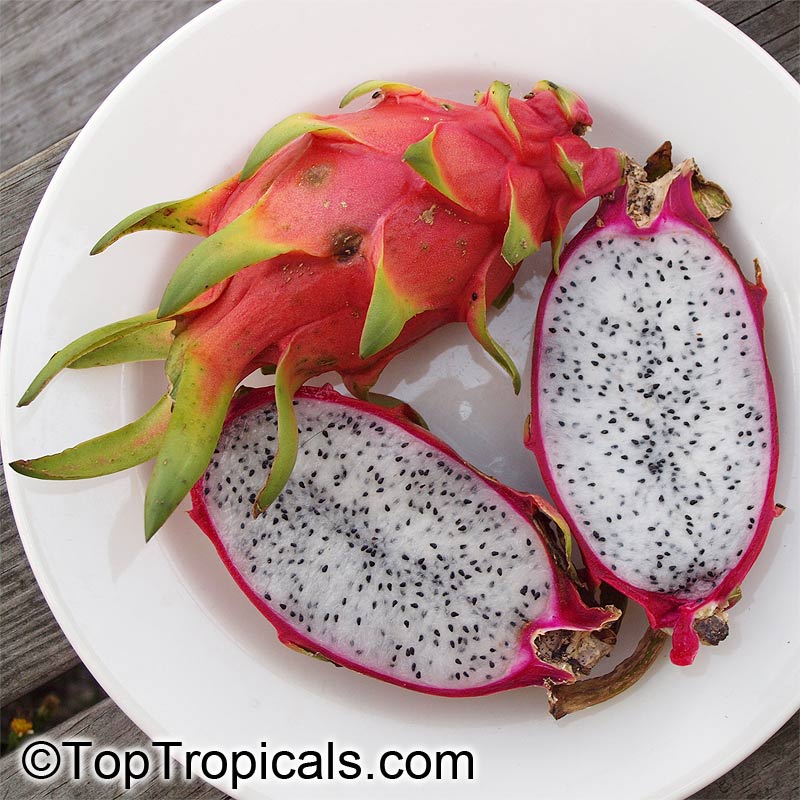
Hylocereus and Selenicereus Dragon Fruit or Pitaya
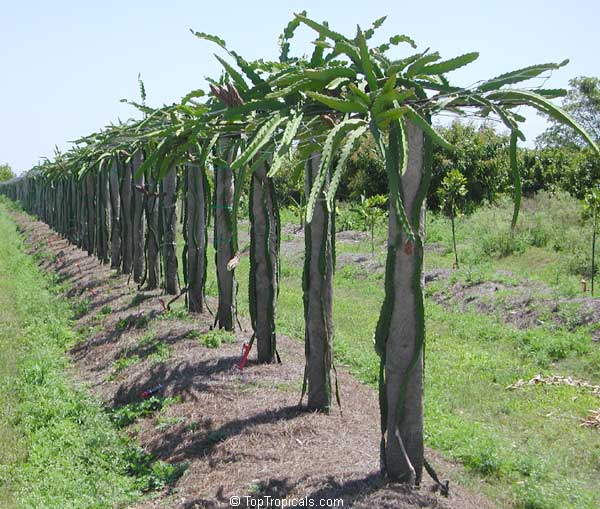
Hylocereus and Selenicereus Dragon Fruit or Pitaya trees on trellis
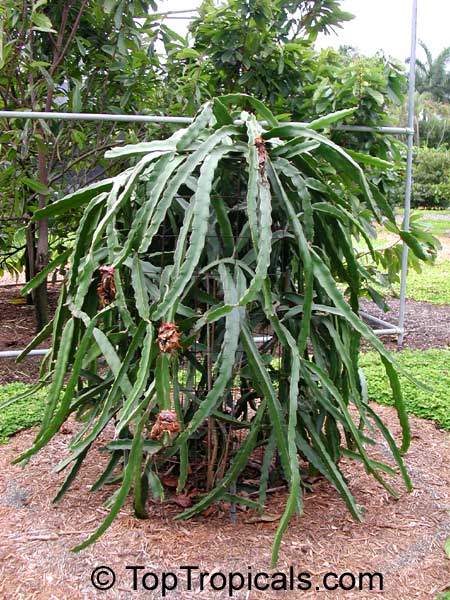
Hylocereus and Selenicereus Dragon Fruit or Pitaya on trellis

Hylocereus and Selenicereus Dragon Fruit or Pitaya red fruit
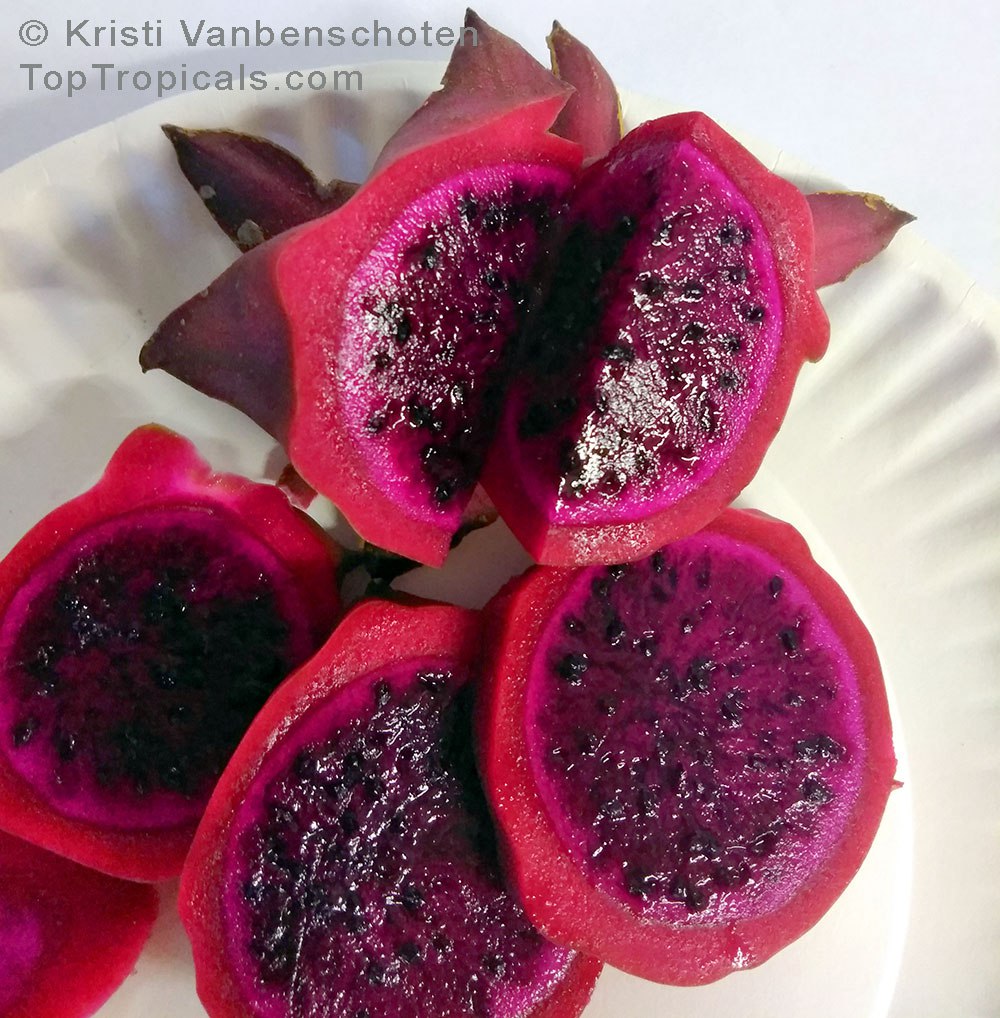
Hylocereus and Selenicereus Dragon Fruit or Pitaya purple fruit
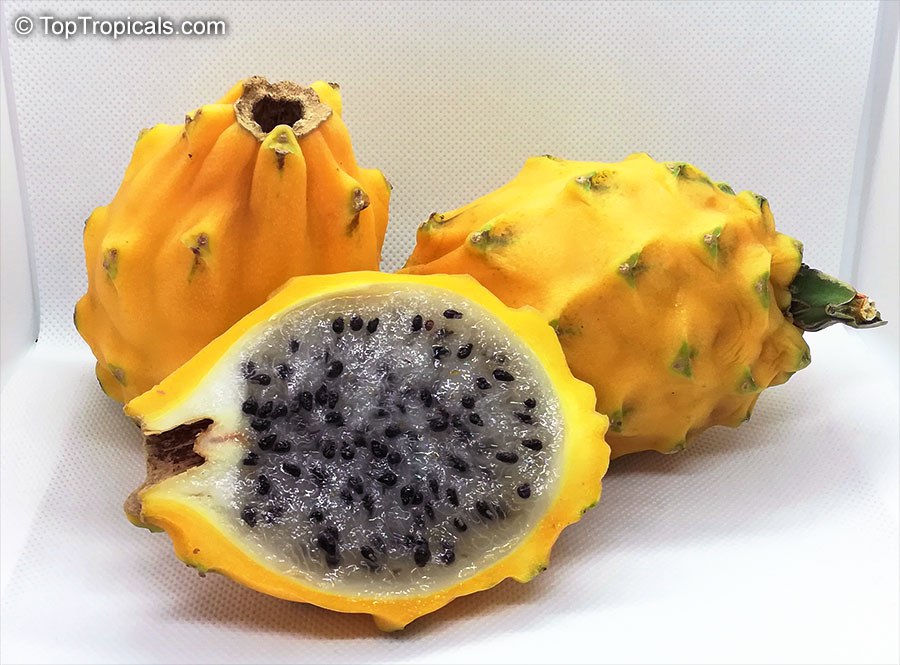
Hylocereus and Selenicereus Dragon Fruit or Pitaya Yellow Parlora
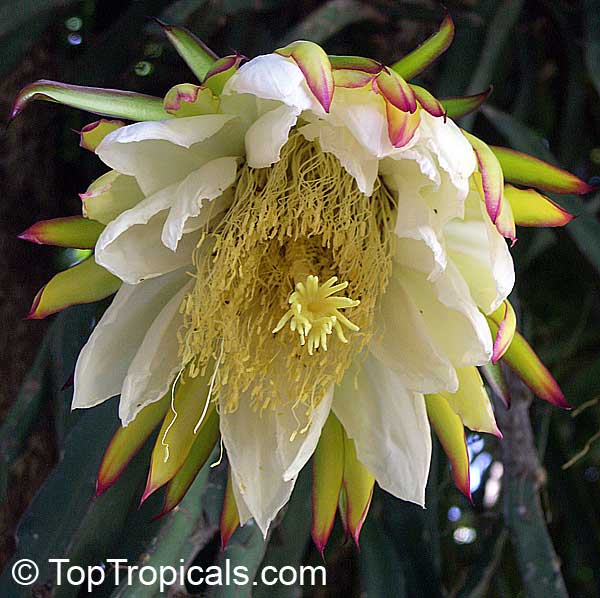
Hylocereus and Selenicereus Dragon Fruit or Pitaya flower
- 🔴 You may have tried a Dragon fruit from the store l, but do you know how it grows? On a cactus tree!
- 🔴 Names: varieties of Hylocereus and Selenicereus - these fruit bearing cactus plants are also called Dragon Fruit or Pitaya.
- 🔴 Commercially grown fruit sold in a grocery store may be tasteless. You need to grow your own good variety to have tasty, sweet, flavorful fruit!
- 🔴 Dragon fruit comes in many varieties. Colors of flesh differ: white, pink, dark red and even purple. The outside of the fruit can be red/pink or yellow.
- 🔴 In commercial groves, Pitayas grow like cactus trees, over a strong support - big "umbrella frames" ☂️
- 🔴 It is an easy plant, with low water needs, takes both sun and semi-shade.
- 🔴 Our favorite variety is Yellow Dragon Fruit Palora, (Selenicereus megalanthus). It is the sweetest and has the most flavor of all. We shared some recipes earlier.
- 🔴 Can be grown in container with a wooden trellis. And the flower is beautiful, too!
📚 Learn more about Dragon Fruit
🍹 Recipe: What to do with a Dragon fruit?
🛒Grow your own Tasty Dragon Fruits
#Food_Forest #Recipes #Nature_Wonders
🏵 TopTropicals
Date:
Container mango - Condo varieties
Q: What are the good varieties of mango trees available for container grow? Can you please share the details?
A: There are some great varieties of Mango selected specifically
for container culture, they even have a nick-name - "condo mangoes". They
have compact growth habit and respond well to pruning to keep them in small
size. Here are a few of our favorites that we currently have in stock:
Glenn
Ice
Cream
Cotton
Candy
Mallika
Manilita
Pram
Kai Mai
Mun
Kun Si
Maha
Chinook
You can see more condo mangoes on this page.
Related articles:
How to grow a Dwarf Mango tree
Choosing the right Mango for your garden
10 secrets of successful Container Mango growing on a balcony.
Condo Mango
